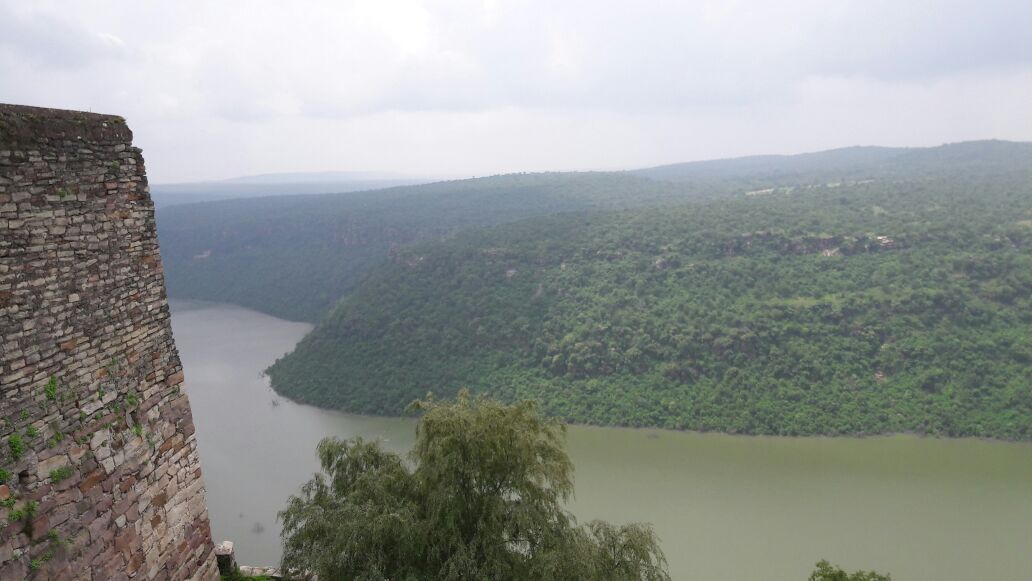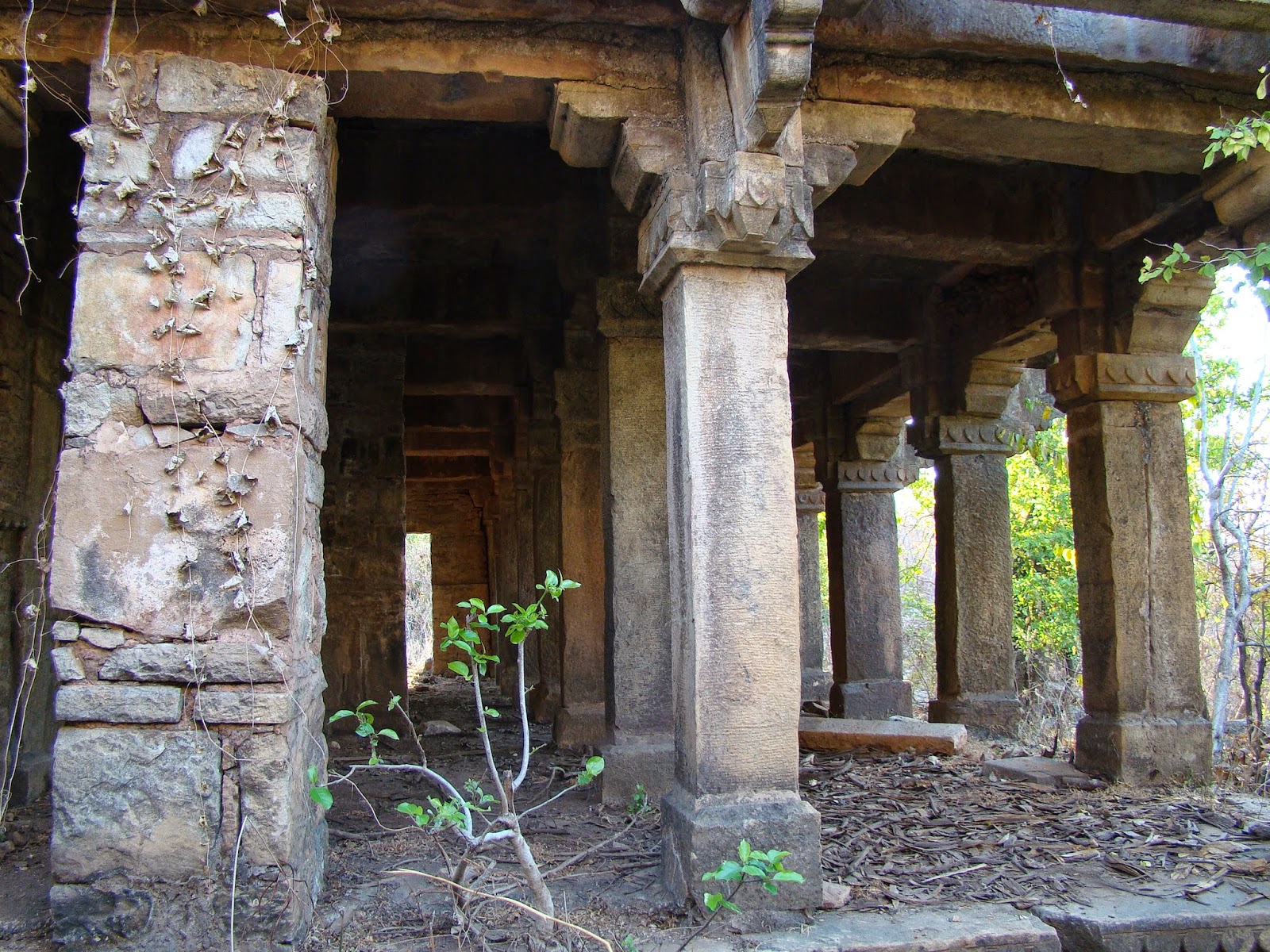Too little is known of this fort”, observed the List of Ancient Monuments published by the Bengal Government in 1896. Lamentably, the same observation holds true even to the present day. The Hill Fort of Sher-Garh also at times known as ‘Badal Garh’, has remained mysterious and has been now lying unattended for more than 400 years, on the eastern banks of the river Durgawati, which flows towards south-west just below the fort, between the two ranges of hills, separating the districts of Rohtas and Kaimur in Bihar. Situated about 32 kms south-west of the town of Sasaram and about the same distance north-west of Rohtasgarh Fort on the bank of the river Sone, it is a natural hill fort sited amidst gorgeous scenery with the top of the rock having a natural rampart well-fortified by a number of bastions and bulwarks. But the real magnificence of the site as well as the constructions can be felt only when visited. The ascent to the Fort through the winding path passing through beautiful gorges is steep and through jungles with a remarkable fauna and flora.
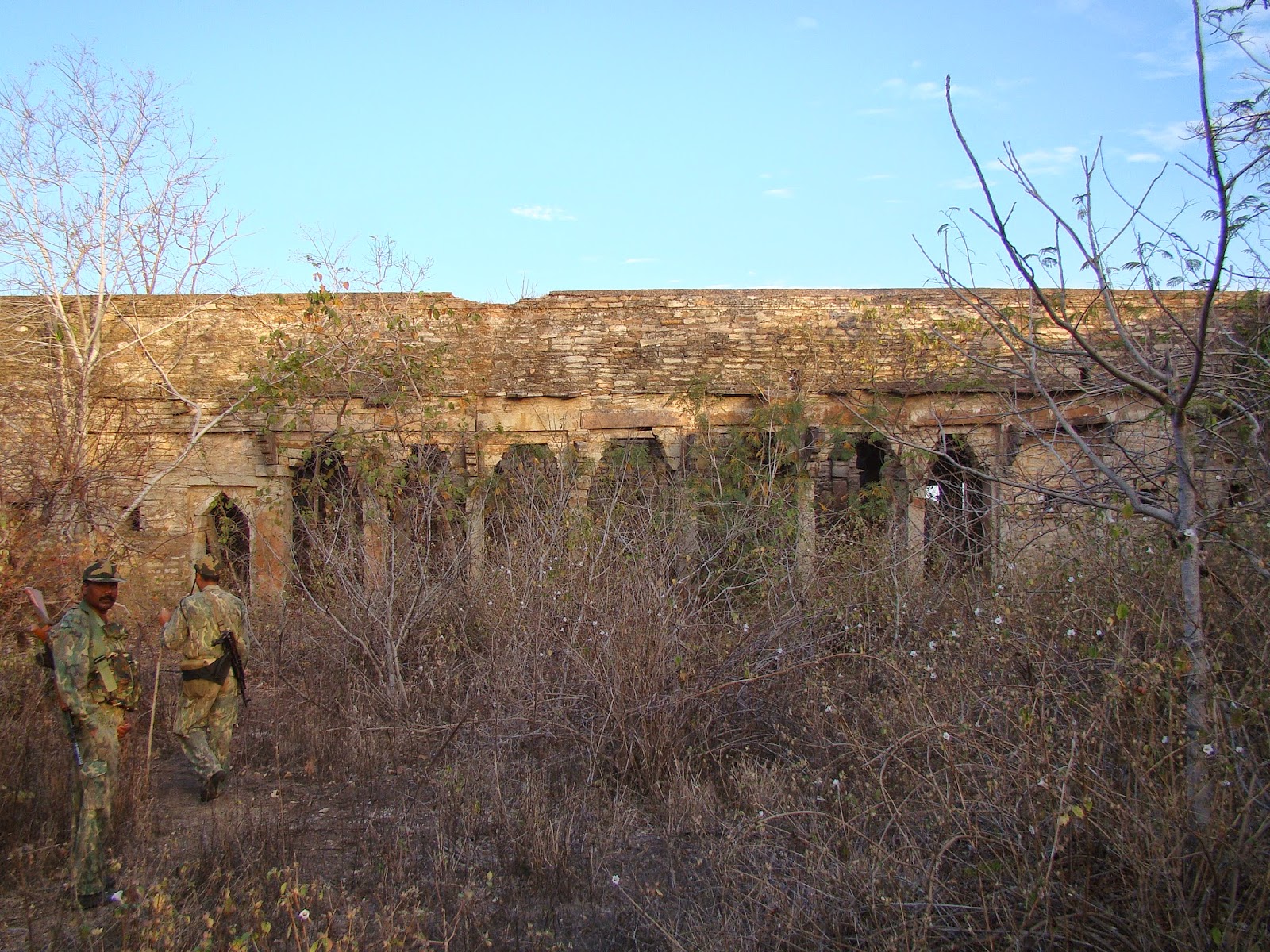
The top of hill, now a mass of ruins commands a magnificent view of the distant range of hills and the valley of Durgawati. Buchanan during his visit (1813) felt that the distant snowy mountains would be visible during clear weather; but now it may not hold so, on account of the air pollution that has ensued in the intervening two centuries. Referring to the elevation, he interestingly narrates about having confused a flock of buffaloes in the river below for a number of swimming water birds. Further, stressing about the magnificence of the Fort, he had even compared the castle on the summit of the small hill at the edge of the precipice to the European castle of Durham.
Location on the Kaimur Hills: Among several natural and historical sites on the Kaimur Hills, which form the easternmost part of the Vindhya Range, Shergarh and Rohtasgarh are the most strategic. Even today, if one is required to guard the Kaimur Hills as a vantage point for a larger empire, the sites would still qualify. Rohtasgarh built at a height upon the most secure portion of the plateau with its base on the banks of the river Sone is the most protected and strategic. Similarly, Shergarh is strategically located at a distance from the Rohtasgarh fort on the other extremity of the plateau with its base on the banks of the Durgawati. While the Rohtasgarh side of the plateau is connected to the main plateau only by a small stretch of rock at Katautea Ghat and is surrounded on two sides by the River Sone and on one side by the Ausane, the Shergarh side is connected to the main plateau, and is protected on two sides by the river Durgawati. The famous stalactite caves of Gupteshwar lie at a distance of only about 11 kms from the fort of Shergarh. These forts strengthen the hold of the ruler over the whole Kaimur Hills and areas in its command. While the stronghold of Rohtasgarh lying on an isolated stretch of the Hills protects from all threats emanating from the east, the stronghold of Shergarh having easy approach to the whole plateau containing the villages, provides protection from the West.
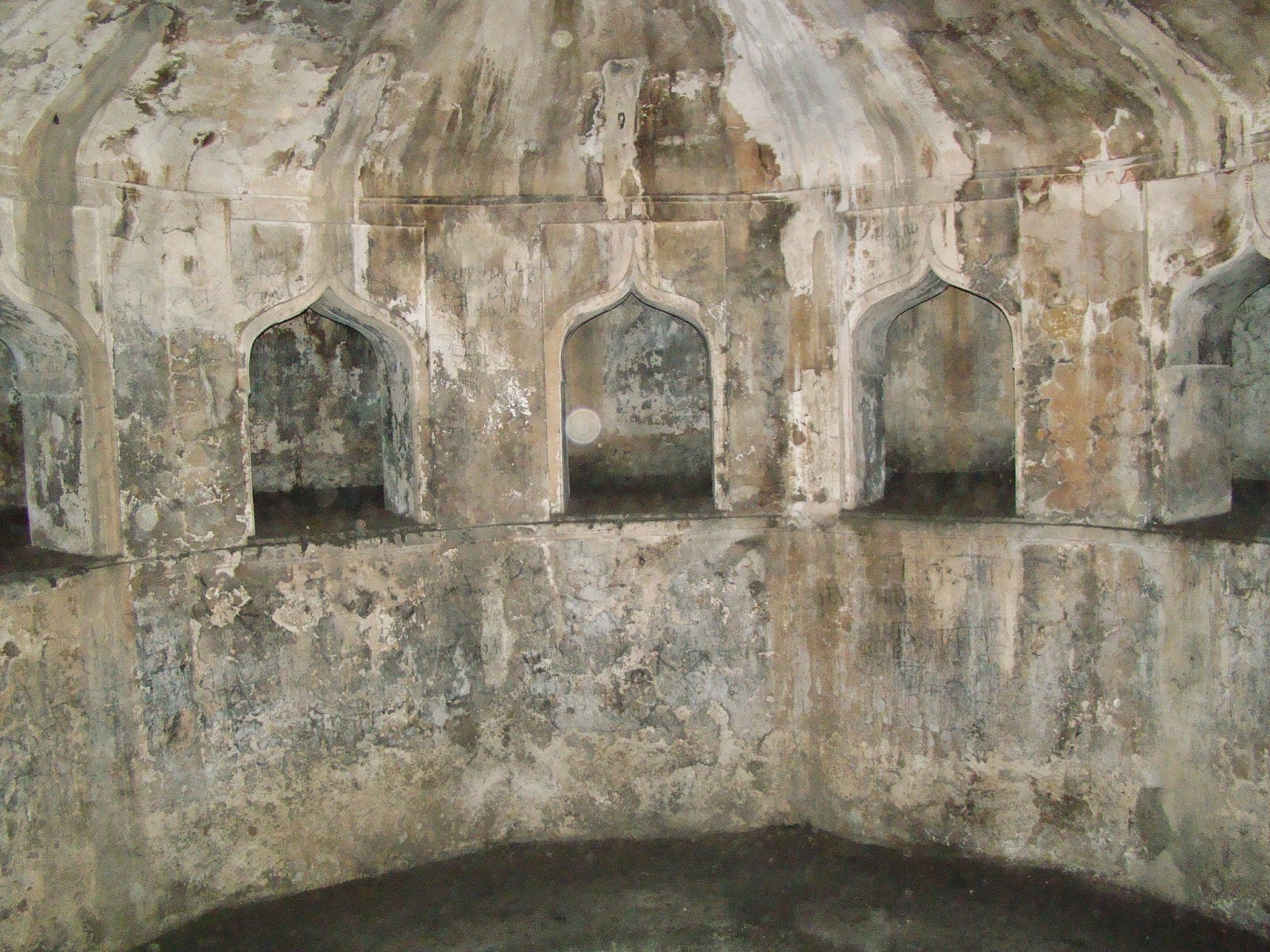
Early Descriptions: The fort of Shergarh was first described in detail by Francis Buchanan, who visited the site on the 7th of January, 1813. His account is found utilized by the Bengal List (1896) as well as by the District Gazetteer (1906). The Bengal List (1896) mentioned that one Mr. Caspersz had visited it, while Mr. Beglar had still not seen the place. In 1902, Theodore Bloch visited the place adding some more information; followed by a more informative account of Kuraishi (1929). The latest informative mention I could find was in the Gazetteer of Shahabad (1966), by P.C. Roy Choudhary, who has ascribed the origin of the fort to the early Rajput rulers of Shahabad, who held the place before its capture by the Afghan ruler Sher Shah Sur, lying buried in his magnificent tomb in Sasaram. I paid a brief visit to the Fort in March, 2010, only to reaffirm that even today it lies in the similar neglected if not worse condition as it was in 1813. The site is neither properly protected and nor have proper excavations have been carried out. The last published Gazetteer of Shahabad (1966), has remarked that the ruined fort being a wonderful piece of nature’s handiwork, human skill and architecture is a beauty spot but seldom visited.
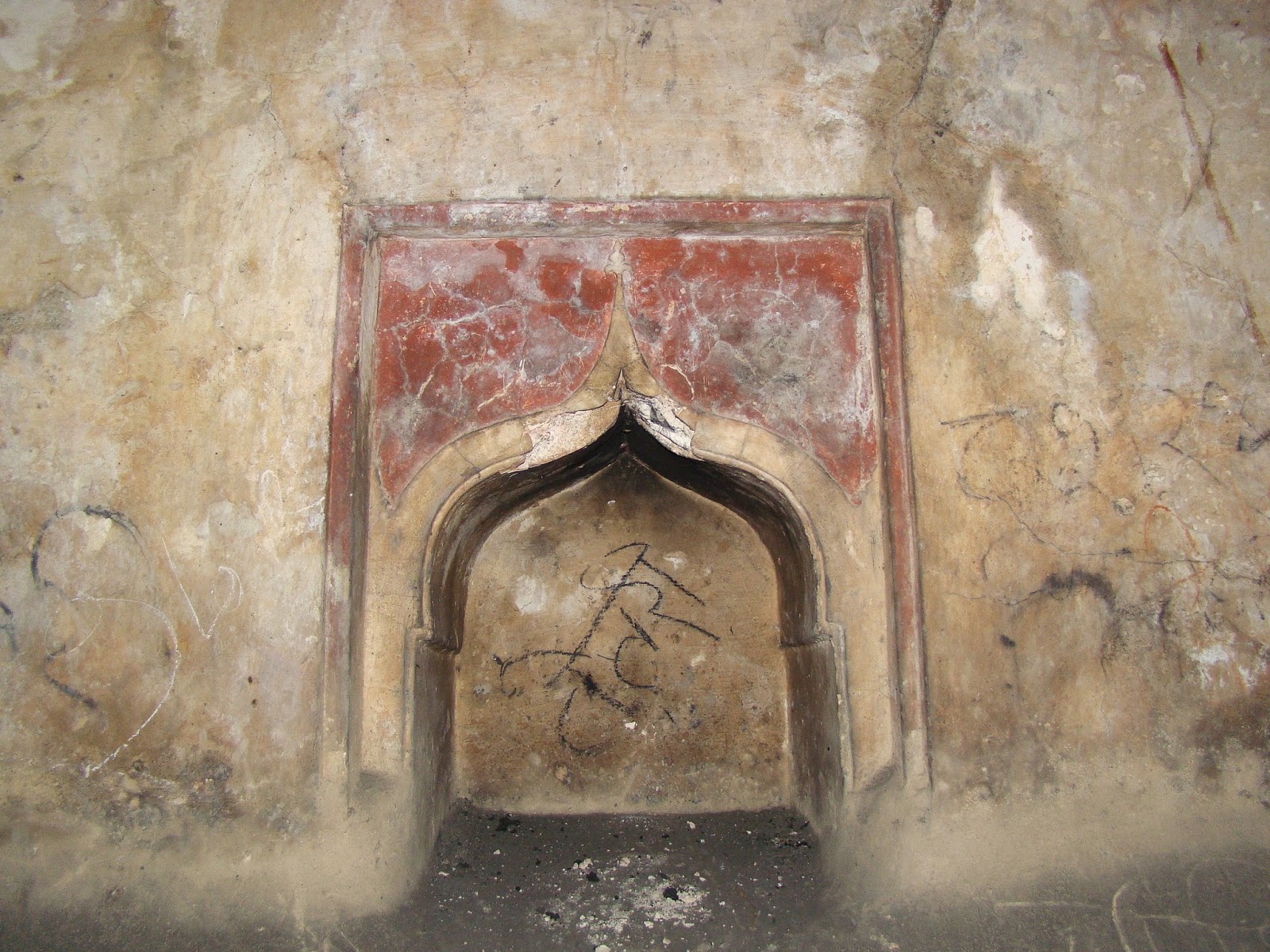
History and Origin: The mysterious origin and history of Shergarh pose a lot of unanswered questions. In absence of any concrete knowledge about the history of Shergarh, Francis Buchanan assumed without much basis that it may have been constructed by Sher Shah after his fortification of the Rohtasgarh Fort. The same assumption has prevailed in the writings of Bloch and Kuraishi on the subject, which however, does not seem to represent the actual facts. Even a lay visit to the Fort makes it quite clear that the very erection must have taken considerable time, and would not have been possible in the five years of rule generally ascribed to the Afghan ruler. Finally, an indication of the earlier history of Shergarh is given in the Gazetteer of Shahabad (1966), in which P.C. Roy Choudhary clearly mentions that the origin of this fort is a mystery and that a casual remark of Francis Buchanan probably inspired by the name of Sher Garh, led to his doubtful theory that Sher Shah had built this fort, which appears to have persisted. He has reasoned out that the fort had existed from before and was the stronghold of the Rajput chieftains, who held Shahabad before Sher Shah, and that it thereafter came to be known as Sher Garh because of Sher Shah’s personality. He mentions that the monuments built by Sher Shah including his self-built tomb and other monuments at Sasaram and elsewhere contained either engraved inscriptions or retained the class of architecture symbolic to his rule. His occupation of the ancient fort at Rohtasgarh is amply borne by the mosques and Idgah there. As Sher Garh does not contain any inscription ascribing its erection to Sher Shah, and nor has any building symbolic of his rule, he found it intriguing that Sher Shah would build this fort without leaving any inscriptions or representative buildings. Also, the drawings and scrolls on the conglomerate along with the underground dancing hall do not typically represent Sher Shah’s legacy; his being known as a pious and orthodox Muslim with sturdy and austere character. Roy Choudhary thus reasons out that in his very brief span as a ruler, Sher Shah after capturing Rohtas Garh might have turned his attention to the existing fort of Sher Garh, ideal as the second line of defence.
The above theory seems to have a historical basis, as several forts occupied by Sher Shah including a fort in Sasaram town and even the Old Fort in Delhi were renamed as Shergarh during his rule. In that case the Fort must have existed since earlier than the 16th century, and was renamed during his rule. The Fort then as it is still today, was at a remote corner and far from human habitation. Strategically important, the approach of enemies could be visualized from a distance of about ten miles on every direction and the enemy could easily be routed while on its way through the zig zag ascent. The underground halls with perennial source of water could be stored with foodstuff to last for months further strengthening the position.
The Fortifications: The Fortifications of Shergarh Fort are visible from a distance as one approaches it. The ascent to the fort is not motorable and one has to disembark from the vehicles at Badalgarh. On walking for about 1 to 1.5 kms one reaches the foot of the stairs that lead up to the fort bastions. The scenery around is mesmerizing. The time I chose to make the visit was early in the morning and just before daybreak. It was still dark when I started on the old rocky stairs, some of which are disengaged from their erstwhile positions making the climb a careful one. As one climbs one soon reaches the first bastions which still retain the glory of the bygone days. One can here only imagine the scene of a few centuries ago, when the fort was buzzing with activities and sentries on the bastions were keeping a close eye on the movements. Even today as one climbs one has the feeling of being watched and under surveillance, but there are no sentries around and the only souls that I could spot around in the morning were some langurs, who were keenly watching at the new human intruders in their usually undisturbed territory.
The altitude of Shergarh is much lesser than that of Rohtasgarh, and it takes lesser time to reach the first fortifications. As D. R. Patil mentions, the rocks are not as lofty as at Rohtas nor is the area so extensive; for the total length of the fortifications encircling the hill is hardly four miles all around, and the fort area is about six square miles. However, the fortifications consisting of battlemented walls which run all around the edge of the hill and, are quite impressive and give a considerable show from a distance even in their ruinous condition. The walls were provided, at irregular intervals, by kiosks and other buildings most of which have now fallen. During the visit while I entered through the main gate from the north to the fort within, the disembarking was from another hilly route which reached downhill at another point almost the same distance from Badalgarh camp.
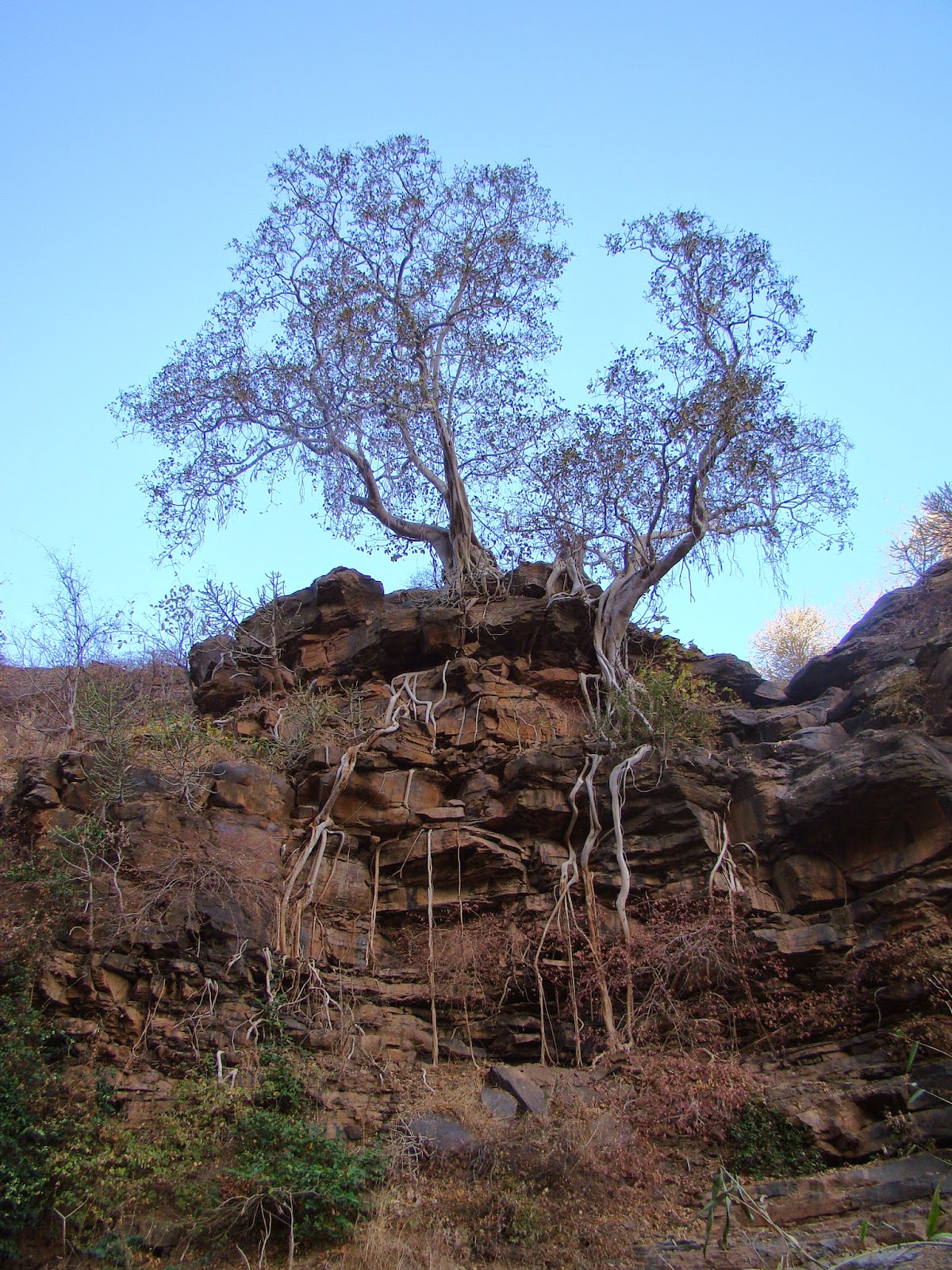
The Ascent: Buchanan described the ascent on the north face of the hill as being much grander than any of the approaches to Rohtasgarh. He also found it as being less considerable both in abruptness and elevation than in most part of these hills, but still very difficult to tread, which was only slightly eased by the stair constructed the whole way with some skill, forming short flights from one corner of a zigzag to another. The stairway consists of a flight of broad easy steps of stone masonry, now much ruined. The gateway[i] here is quite large but is in ruins except for the bastion on its northern side which still exists. On the inner side of this bastion are the barracks for the guards which consist of a large pillared hall, 60’ by 40’, roofed over with stone slabs, the flat roof being surrounded, on the top, by a series of pillared kiosks or sentry boxes with low parapet walls in between. The ascent must have been easier when the stairs would have been entire, as the steps were seldom more than 9 inches high, but the greater part was already broken in 1813, as it is now. Despite the rudeness displayed by the irregularly squared stones which often had exceedingly awkward landing places from one flight to another and quite irregular breadth according to the nature of the ground, some parts being at least 20 feet wide, have been described as appearing like a grand work by Buchanan.The ascent is in many parts completely commanded by the defences, so that while these remained entire no person could pass up without being completely exposed to a destructive fire.
The Citadel and Palaces inside: As one reaches the plateau from the stairs, one gets a feeling of being in an abandoned and ruined forested settlement, as no proper buildings are visible in the vicinity. As mentioned in the Shahabad Gazetteer (1966), the plateau on the hill is divided into two natural elevations with a low depression in between occupied by a natural reservoir fed by rain water. The tank had been earlier lined with masonry but is now mostly dry. The lower side of the plateau is now a thick jungle and possibly contained no buildings; but on the higher elevation towards the south, is the citadel containing the palatial buildings supposedly erected by Sher Shah. The main gate of the fort opens out into two large covered dalans supported by pillars both to the east and west and either of them could accommodate about 1000 persons, as mentioned by the Gazetteer. Buchanan has described the space within as exceedingly rugged, which is quite the same impression that the visitor today would also experience. He has mentioned that the castle which occupied part of the west side of the fort overhanging the Durgauti made a very conspicuous figure from the eastern gate and from a terrace that conducts along the bottom of the hill in the southern part of the fort. The most even part extends along the east face to a hill which runs between two recesses, one from the north and one from the west, that reduce the level to a narrow neck, and from each of which there has been a gate. Buchanan felt that between the eastern of these gates and the northern gate there had been a large bazar, and the ruins of many stone huts were still found to be remaining.
Bada Angana with Underground Chambers: As one walks through the clearing one reaches the main gate which leads to the main citadel. The main gate, now in ruins, is flanked, on both sides, by two large pillared and flat-roofed halls, measuring 30’x18’ and 41’6”x18’ respectively .These halls, it is said, were once used as offices. Further up another flight of steps leads to a small gate, also in ruins, which was once elaborately decorated with carvings. The palace buildings are arranged round two courtyards, of which the larger one was called as Bada Angana and the smaller one as Chhota Angana. The larger court is about 300’x200’ and is surrounded by a series of oblong rooms, meant for the attendants, galleries with covered stair and a set of ladies chambers in the middle of each side. Some of the door jambs are seen with elaborate carving in geometrical designs. The roofs are flat, supported on pillars and brackets. In the centre of this larger court is a tank, mentioned by Patil to be 23’9” square and 11’ deep, surrounded by a 12’ wide covered and pillared gallery. On entering the larger court, the first thing that strikes is the near absence of over-ground structures. However on a careful perusal, one notices the hidden passages to the underground chambers within. Standing on a level ground, as one discovers the underground passage, one realizes that one is actually standing on a hidden group of chambers within. Referring to this, Buchanan described that the area formed the roof of a number of apartments which had no light or air except through some small apertures in the terrace. The passages into some being filled up, he had descended into two of them by “wretched stairs”. A first time visitor even today can miss these chambers, if not acquainted with their existence.
The three under-ground chambers have been described as follows:
- a)Nach-ghar or dancing hall measuring about 48’x45’, in the south western corner consists of a 24’ square chamber surrounded by a 8’ wide verandah and lighted by arched openings on all the sides,
b)Raniwas in north-western corner, perhaps meant for the chief lady of the harem, consists of a larger chamber, 59’x37’, with a narrow gallery on its east, and covered by a series of domes and vaults, supported on masonry pillars, and provided with square ventilators at the top, and
- c)Chhota Raniwas to the north of the tank or to the east of the Raniwas as above, consisting of a small domed room only, but with a very fine plaster.
The purpose of these underground chambers is not fully established, and they do add to the mystery surrounding the place. Buchanan suggested that these underground chambers were meant for the accommodation of ladies in the time of a siege and as cool resorts in hot weather; but Kuraishi took them as store rooms. In view of the strong plaster on their wall which had not suffered in the least till when Buchanan visited Shergadh, there is reason to believe that they were used for residential purposes. I could deduce that they must have had a residential purpose since several apartments also had lamp stands from which almost fresh layers of soot were visible, implying that they were regularly lit up during stay.
Chhota Angana: The Chhota Angana, or smaller courtyard, lies to the west of the larger court. It is square shaped and is enclosed by walls, with a small room at each of the four corners, and pillared galleries in between. Access to this court was through two covered stairways from the roof of the larger court to the east. According to Kuraishi the rooms here were used as kitchens or servants’ quarters. Dr. Bloch suggested that they were used as Ladies’ quarters. A door in the west wing commands a prospect of great beauty over the hills and valleys beyond the Durgawati river.
The Massacre at Sher Garh: Buchanan mentions that such strongholds were then desirable in India as being a strong depot for treasure, records and arms and as a security not only against foreign invaders but also popular commotion and rebellion. He mentions that the princes always had a fear of the shifting loyalties of the general population, and the extreme barbarity of the times rendered princes anxious to have a stronghold for the protection of their women and children. Buchanan mentions that the family of Sher Shah, who had taken refuge in the Shergarh Fort, were all put to death by the armies of Humayun, the Mughal ruler. He states, “The family of Shere Shah experienced no such indulgence from Humaiyun, although among the cruel descendants of the bloody Timur he has the character of a mild prince. He not only put Adil Shah his competitor to death, but it is here said issued orders that none of the family male or female should be spared. The terrified women of course took refuge in Sheregurh, which could not defend them on the general surrender of the country; not that the Mogols could take it by force, but the supply of provisions could not last long. On their surrender the whole are said to have been thrown down the precipice, and the fort has ever since been totally abandoned, and is beheld with terror on account of this dreadful catastrophe.” Whether this is a historical fact or whether it has emerged from what Buchanan had gathered during his visit is not clear since Buchanan makes no mention about it.
The Mystery remains: Several aspects of this fort including the date of its first construction and the builder still remain mysterious. Adding to the mystery are the several underground chambers that the Fort possesses, the remnants of which indicate very superior engineering skill. The mystery is deepened by the remains which lie buried under the debris and the jungle, which have the potential to spring major surprises upon proper excavation. Though there are several legends in popular memory about the Rohtas Fort, the legends about the Shergarh Fort are very less. This adds to the overall air of mystery that is attached to the Fort, which lies desolated since it was first depopulated.
A visit to the Fort however makes it very clear that it had been made with a very special purpose, and that it had housed several important families during its heydays. Why it was abandoned and what led to the total depopulation is not clear. The Fort though strategic has its own issues. D. R. Patil mentions that the Fort must have been miserable as a place for the residence of women, with the heat being intolerable considering that the rock within the walls is almost everywhere bare and the thinly scattered soil produces only a few stunted trees, so that within the fort there was nothing to relieve the eye from the parching glare of the sun. The surface is also exceedingly uneven, a small hill running along its eastern face and another on its south side. However, Buchanan found that if intended for the capital of the Gangetic provinces alone the choice was judicious, as the climate of the plain at a distance from the Ganges is healthier than near its banks.
Perspective: The site of Shergarh has rather been unfortunate since despite the unique features, it has never emerged as a tourist destination. It did not even attract the attention of Alexander Cunningham, who had camped in the neighbouring areas looking for Buddhist sites, guided by the travelogues of Hieun Tsang and Fa-Hian. The site was visited by Bloch in 1902, and a mention was made in the Annual Report of the Archaeological Survey of the Bengal Circle for 1902-03. No significant subsequent examination seems to have taken place, and perhaps the place has not been excavated at all. It lies unprotected left to decay at the hands of the various vagaries of nature. The ramparts and the bastions are fast decaying and the first gate will now not stand its own for a long time. The beautiful courtyards with the pillars having very delicate and artistic designs, are full of jungles and snakes. The fort chambers have often been used by the outlaws for shelter, and since they are seldom visited by even the law enforcers, they naturally provide a safe shelter. I remember that a media team which had visited the fort in 2011, had encountered persons, who they later came to understand were Maoists.
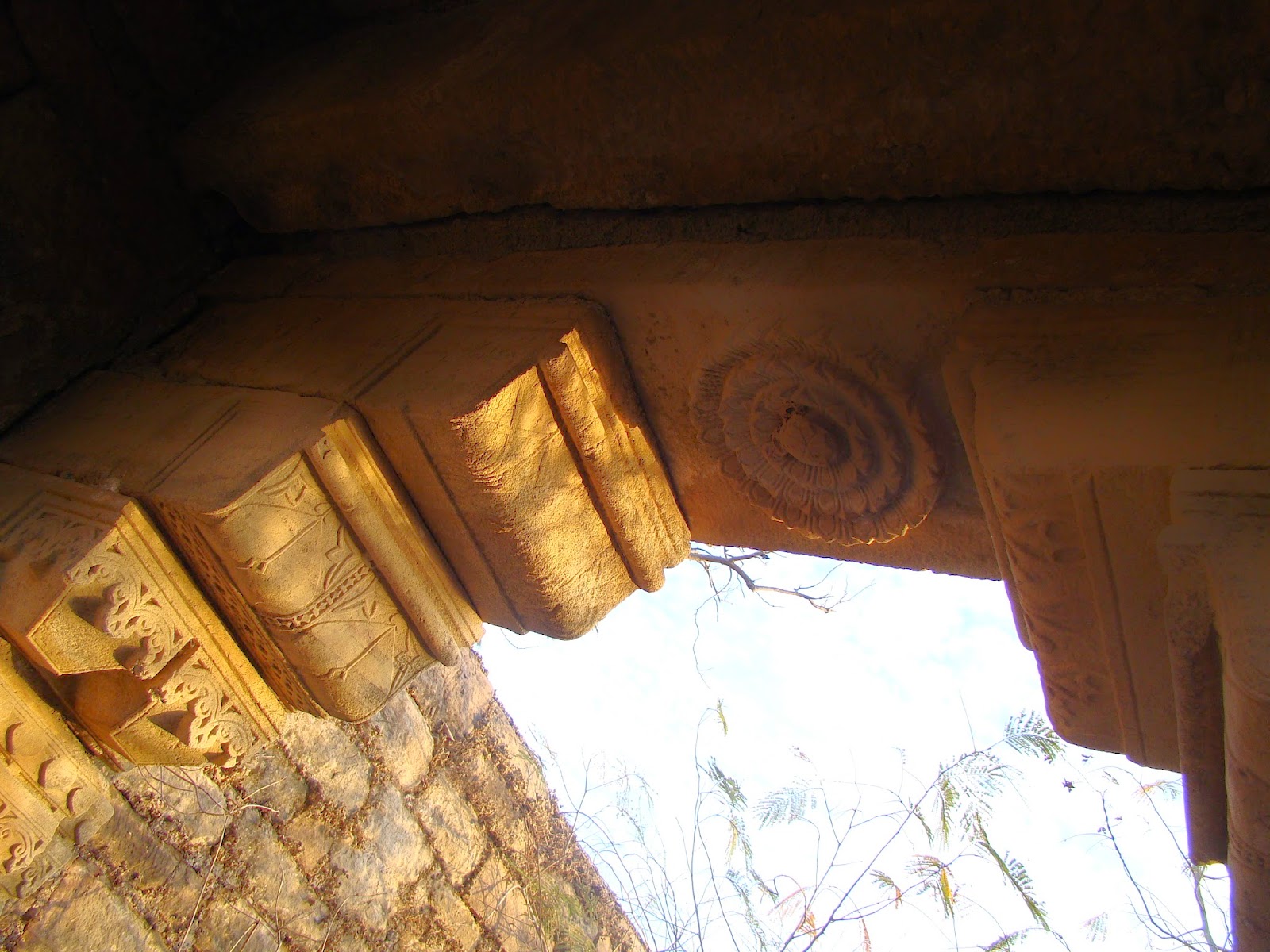
The Future: The future of the site of Shergarh doesn’t appear bright as for almost two hundred years since Buchanan had noticed it, hardly much has changed. There have been occasional visitors ranging from police personnel, media personnel to outlaws, but all have only reported about the misery of the place, and had no solution to offer. The future of the vicinity below the hills however, shows a bright potential. A major irrigation project was recently inaugurated here by the Government of Bihar. Good roads now connect the approach of the hill from the Grand Trunk road, and the site can be reached within one hour by taking a diversion from the GT Road.
On being compared to the Rohtasgarh Fort, the importance of Shergarh appears dimmer, but it had its own purpose to serve in history, and it has its own surprises, which are still not properly studied. The site badly needs strong measures for its conservation, even more than it needed two centuries earlier, if the remains are to be preserved for the benefit of the upcoming generations. A proper study also needs to be made about the origin and the history of the fort. A clearing of the jungles which are eating into the bulwarks of the fort, needs to be taken up urgently along with restoration of the main ascending stairway. I am sure that if proper excavations are taken up in the vicinity, they will definitely enlarge our scant knowledge about the history of the region. And that would also serve as an actual tribute to the author of the Bengal List, who in 1896, had lamented about the lack of much knowledge about the fort.


